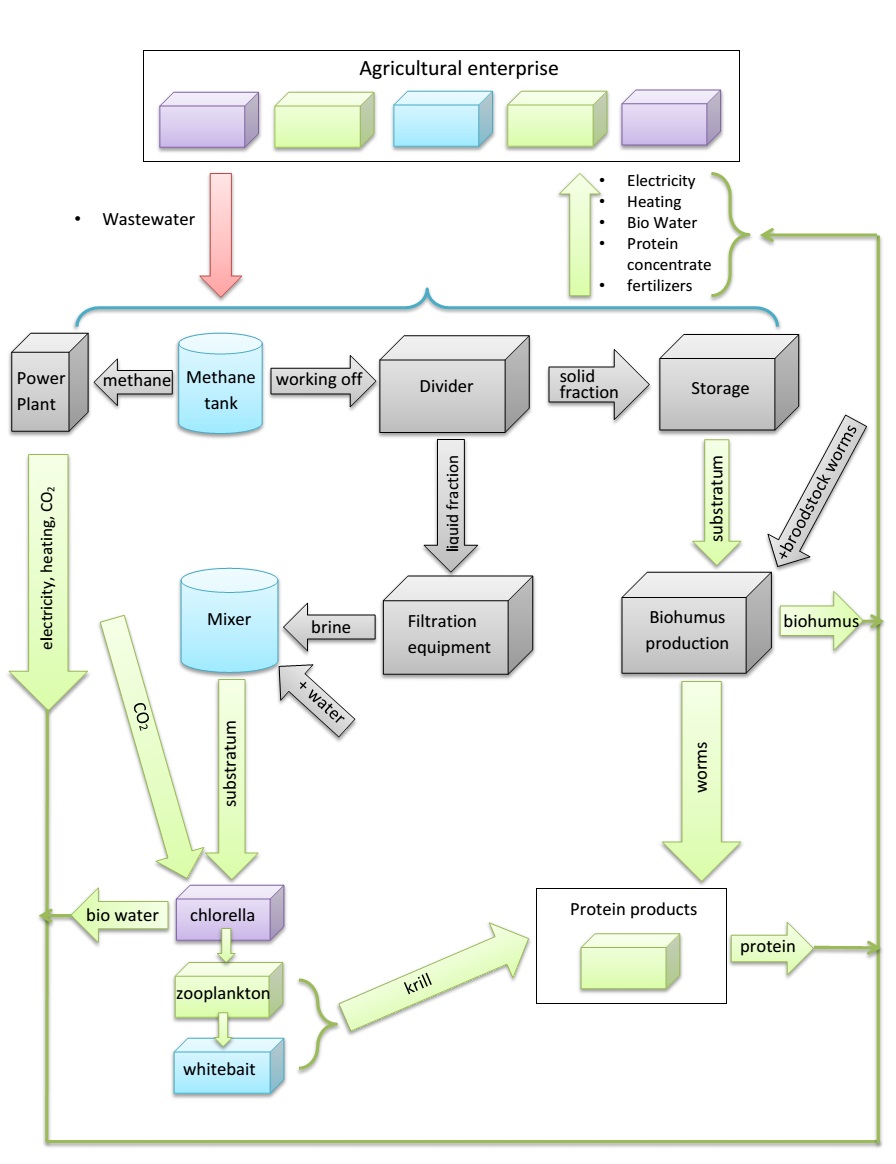
Plan of constructing a system to minimize the negative impact on the environment for livestock and poultry farms.
Plan of constructing a system to minimize the negative impact on the environment for livestock and poultry farms.
Developed by LLC SPA "Algobiotechnologiya"
Impact of agriculture on the environment is disastrous. The main difference of the impact of the agricultural from industry’s impact is their distribution over large areas. The use of large areas for agricultural purposes is a radical restructuring of all the components of natural complexes. Impact of livestock on the natural landscape is characterized by a several specific features. The first is that livestock landscapes are composed of diverse but closely interrelated parts, such as grasslands, pastures, farms, waste disposal areas, etc. Each part is making a special contribution to the overall flow of the impact on natural systems.
The livestock sector is a major consumer of water, accounting of the total agricultural water withdrawals account for about 70% per year. The most negative side effects of livestock on the landscape is pollution of natural water from wastewater of livestock farms. Increasing concentration of organic matter in freshwater, and then in the coastal marine area zone significantly reduces the concentration of oxygen in the water, leading to a change in the community aquatic organisms, disruption of the food chain, can cause the death of fish and other consequences. For example, all of the pet cow consumes most of water about 50 to 60 liters per day. Farm of cattle of 1000 animal waste produces about 47 thousand tons per year. But farm poultry of 400 thousand layers receives in a year such amount of manure that decomposition of its allocated about 700 tons of biogas, including 450 tons of methane (65%), 208 tons of carbon dioxide (30%), 35 tons of hydrogen, indole, skatole, hydrogen sulfide, ammonia and other compounds (5%).
In order to reduce the negative impact of agricultural enterprises on the environment and reduce costs, a special scheme of agricultural production was developed by us in Russia. This scheme will help to solve the following tasks:
- Improved reliability and security of power supply farm:
- installation on the farms own bioenergy plant operating on its own biogas produced from manure and other organic waste;
- creating an additional source of heat from the heat recovery heat exchanger released during the processing of organic waste by anaerobic digestion.
- Improving the environmental safety:
- termination of the release of biogas (methane) and other decay products of bio-organic waste (especially in the presence of lagoons, septic tanks and sewage treatment plants), as well as natural gas for heat flow;
- termination of receipts neutralized manure and other organic waste into the soil;
- preventing the spread of nutrients in stormwater, groundwater, flood and other waters;
- reducing the consumption of drinking water for animals from outside sources.
- Improving economic efficiency and inflow of economic benefits:
- reducing costs for the payment of electric power from the outside;
- reducing costs for the payment of natural gas;
- reducing costs for the payment of mineral fertilizers and their partial replacement of organic fertilizers and their implementation to other farms;
- reducing costs of the payment of drinking water for animals;
- reducing costs of plant and protein foods for animals
- reduction of greenhouse gas emissions resulting from the implementation of the project.
We describe how it should work in the conditions of agricultural enterprise to reduce the impact on the environment. Any farm animals impact on the environment through the discharge of wastewater containing waste of animal’s life. The concept involves the application of the wastewater in "methane tank", where anaerobic bacteria decompose of organic compounds into combustible gases (methane, propane, butane) and working off. At the same time, the gases used in the production of electricity and heat in the "Power Plant" for lighting and heating of production and ancillary facilities, and worker’s houses or for sale.
Working off of methane tank is divided into liquid and solid fractions in the "devider". The solid fraction is mixed with cellulose containing components (straw, sawdust, shavings, twigs, etc.) in the "storage" and is used to food for earthworms ("california" or "staratel"). The liquid fraction is filtered in the "filtration equipment" and after brine enters a "mixer", where after adding water get a substratum for the cultivation of microalgae chlorella. Chlorella is capable of producing a lot of organic protein from inorganic compounds into substratum with sunlight and carbon dioxide, that coming from the "Power Plant". This way water is cleaned and acquires the properties of "biowater", which has a beneficial effect for any living organism, and of course for farm animals. This water could be a habitat, and the chlorella could be food for different species of crustaceans (zooplankton). Zooplankton is used like food for whitebait. Together with worms, they are protein products for animal feed.
Constructed in this way agricultural enterprise has the property of minimal negative impact on the environment. In addition, the cyclical use of water and recycling of waste in protein concentrates, can reduce production costs. And its own electricity and heating can increase the profitability of the enterprise.
